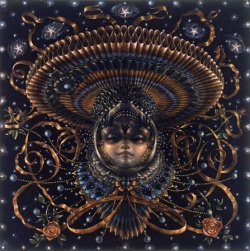Cakkaratana
Buddhist and Indian religious texts outline the belief of a cyclic ruler known as the Cakkavatti or Chakravartin, who like the Buddha, appears rarely at the downside end of cyclic periods. When the dharma or law has decaded to its lowest state, the Cakkavatti is born and there eventually arise certain treasures that are said to aid this new king in washing out the old and bringing in a new golden age. The most important treasure is the Cakkaratana, an animated discus or wheel-like "being," that descends out of its place in Heaven known as the Cakkadaha. It has the appearance of three concentric wheels moving at once. Cakkaratana seems to have a spirit of its own. It travels to the Cakkavatti King, who then anoints it with water and talks to the Cakkaratana asking it to help him conquer the world. When the Cakkavatti is about to die, the Cakkaratana knows this and eventually disappears only returning after his successor has lived righteously for seven days. It,s a One of the seven treasures of a Cakkavatti. When a Cakkavatti is born into the world, the Cakkaratana appears before him from the Cakkadaha, travelling through the air (J.iv.232, but see Vepulla).
The Cakkaratana is the Cakkavatti's chief symbol of office; on its appearance before him, he sprinkles it with water and asks it to travel to the various quarters of the world, winning them for him. This the Cakkaratana does, carrying with it through the air the Cakkavatti with his fourfold army. Wherever the Cakkaratana halts, all the chiefs of that quarter acclaim the Cakkavatti as their overlord and declare their allegiance to him. Having thus traversed the four quarters of the earth, it returns to the Cakkavatti's capital, and remains fixed as an ornament on the open terrace in front of his inner apartments (D.ii.173f; M.iii.173ff).
The Commentaries (E.g., DA.ii.617ff; MA.ii.942ff) contain lengthy descriptions of the Cakkaratana: it is shaped like a wheel, its nave is of sapphire, the centre of which shines like the orb of the moon, and round it is a band of silver. It has one thousand spokes, each ornamented with various decorations; its tyre is of bright coral; within every tenth spoke is a coral staff, hollow inside, which produces the sounds of the fivefold musical instruments when blown upon by the wind. On the staff is a white parasol, on either side of which are festoons of flowers. When the wheel moves, it appears like three wheels moving one within the other.
When a Cakkavatti dies or leaves the world, the Cakkaratana disappears from the sight of men for seven days; it gives warning of a Cakkavatti's impending death by slipping from its place some time before the event (D.iii.59f.; MA.ii.885). When his successor has lived righteously for seven days, it reappears (D.iii.64).
It is the most precious and the most honoured thing in the world. UdA.356." </poem> www.payer.de
